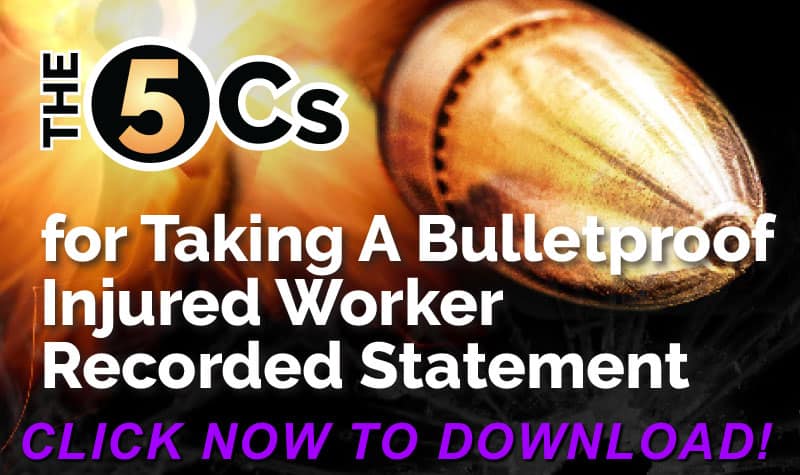
Preparing for the Recorded Statement
Understanding the various laws and regulations is crucial when preparing for the recorded statement. It should often be done early in the claims process. Be sure to communicate with the employee’s attorney if the person has retained legal representation.
- Familiarize yourself with the claim: Review the claim file and relevant documents before conducting the recorded statement. Understanding the details of the incident, medical reports, and any available witness statements will help you ask targeted and informed questions.
- Establish a conducive environment: Choose a quiet and private location for the recorded statement to ensure confidentiality and minimize distractions. Inform the injured employee about the statement’s purpose and provide reassurance that their cooperation is valued.
If possible, consider using a Webex system to personalize the process and maximize the effectiveness of the process.
Click Link to Access Free PDF Download
“The 5Cs to Taking a Bulletproof Injured Worker Recorded Statement”
Building Rapport with the Employee
Never go into a recorded statement with an aggressive posture. Empathy and compassion are required. Remember the old proverb, “You can catch more flies with honey than with vinegar.”
- Create a comfortable atmosphere: Begin the conversation with a friendly and empathetic tone to put the injured employee at ease. Active listening, showing empathy, and demonstrating respect throughout the process help establish rapport and encourage open communication.
- Explain the process: Clearly explain the purpose of the recorded statement, its significance in the claims process, and how the information will be used. Assure the injured employee that their account is essential for accurately assessing the claim.
Asking Effective Questions
The purpose of the recorded statement is to obtain as much background information as possible early on in the discovery process. Getting the employee to talk as much as possible is vital.
- Use open-ended questions: Ask open-ended questions to encourage the injured employee to provide detailed and comprehensive responses. This helps uncover relevant information and allows the employee to explain their perspective in their own words.
- Sequence the questions logically: Structure the questions in a logical order, starting with the incident itself, followed by questions about the resulting injuries, medical treatment, and any prior medical history that may be relevant. This ensures a smooth flow of information and helps capture a complete picture of the claim.
- Seek clarity and specific details: Ask follow-up questions to clarify any ambiguous or incomplete responses. Encourage the injured employee to provide specific details such as dates, times, locations, and descriptions of the incident and subsequent injuries. This helps establish a clear timeline and accurate understanding of the events.
Use a language translation service, or offer one if the employee does not use English as their primary language. People who speak English as a second language, even if for a long time, can be intimated by not speaking their native tongue in any legal-type proceeding. Offering to use a translation is also another technique to develop rapport and provide calm.
Active Listening and Documentation
Use your ears to listen and not your mouth. It also may help to take simple notes during the process and then go back and write down additional information afterward.
- Listen attentively: Pay close attention to the injured employee’s responses and actively listen to their account. Take note of any inconsistencies, information gaps, or areas requiring further investigation.
- Document accurately and objectively: Take thorough and accurate notes during the recorded statement. Use the injured employee’s words whenever possible to maintain the integrity of their account. Avoid assumptions, personal opinions, or leading questions that could bias the recorded statement.
Again, always treat the employee with dignity and respect. Avoid being judgmental.
Closing the Recorded Statement
Complete the recorded statement with the same professionalism as it began. The employee may have questions. Take the following steps before terminating the call or online session.
- Recap and verify the information: Summarize the information provided by the injured employee and confirm its accuracy. Allow the injured employee to add any additional details or correct any misconceptions.
- Address any concerns or questions: Inquire if the injured employee has any questions or concerns related to the claim or the recorded statement process. Addressing these promptly can help alleviate any uncertainties and ensure a positive experience.
It is also crucial to be aware of procedural steps that need to be completed for the statement to be admissible at a hearing. Failure to take these steps can have negative consequences.
Conclusions
Taking an effective recorded statement in workers’ compensation claims is a critical aspect of the claims process. By preparing adequately, building rapport, asking effective questions, actively listening, documenting accurately, and showing empathy, any claim handler can take a better recorded statement.

Contact: mstack@reduceyourworkerscomp.com.
Workers’ Comp Roundup Blog: http://blog.reduceyourworkerscomp.com/
©2023 Amaxx LLC. All rights reserved under International Copyright Law.
Do not use this information without independent verification. All state laws vary. You should consult with your insurance broker, attorney, or qualified professional.














